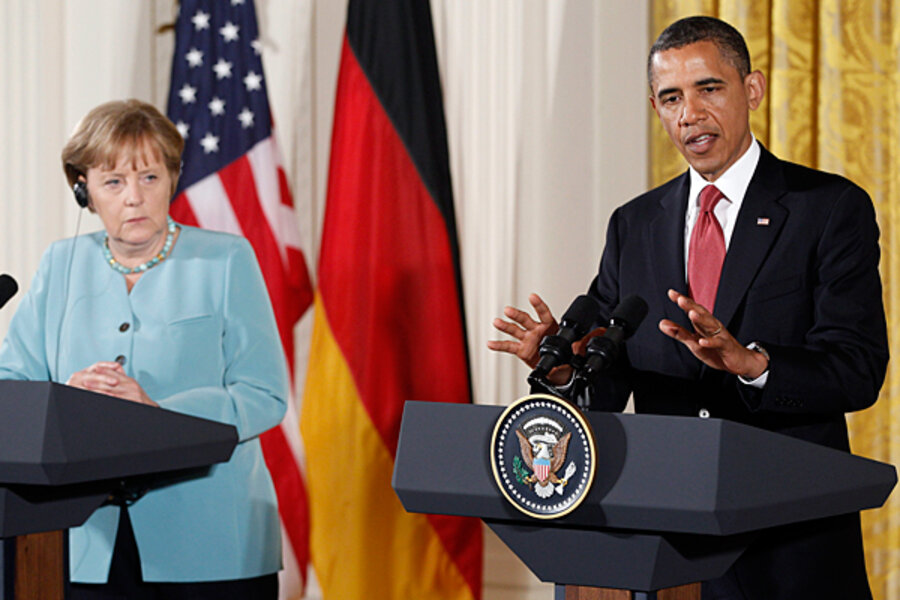Germany to phase out nuclear power. Could the US do the same?
Loading...
In their White House press conference Tuesday, President Obama and German Chancellor Angela Merkel stood together on topics ranging from the global economy to Libya.
Yet last week, Chancellor Merkel parted ways with the US on what had been a shared vision of how to maintain thriving economies while reducing greenhouse gases. For both nations, part of that plan had been nuclear power. For Germany, it is no longer.
In the wake of the Fukushima nuclear disaster in Japan, Merkel announced that her country would close all of its 17 existing reactors by 2022. Other nations, including Japan, Italy, and Switzerland, have announced plans to pare back nuclear power, but none have gone as far as Germany, the world’s fourth-largest economy. Merkel vows to replace nuclear power with alternatives that do not increase greenhouse gases or shackle the economic growth.
Could the US do the same? An increasing number of reports suggest it is not beyond the realm of possibility, and Germany could provide a road map. "Germany is conducting what I call a grand laboratory experiment," says Mark Hibbs senior associate in the nuclear policy program of the Carnegie Endowment for International Peace.
"Over next 10 years, the Germans will be challenged to make use of all of those [alternative] energy technologies to do what they need to do,” he adds. “If they succeed, its very likely we will see other countries give their nuclear programs a complete rethink."
America gets about 20 percent of its power from nuclear – similar to Germany’s 22.6 percent. Likewise, nuclear-energy advocates in America and Germany have cast doubts on renewable energy’s ability to meet the “baseload” power traditionally provided by coal and nuclear plants without harming the economy.
"There are plenty of studies showing that nuclear is key in providing baseload power,” says Mitch Singer, a spokesman for the Nuclear Energy Institute, an industry trade group in Washington. Noting that changes in wind and clouds can affect renewable-power generation, he adds: “Wind and solar are so variable they really present a problem when you put that much on the grid."
Yet an increasing number of studies also suggest that the US could at least begin to follow in Germany’s footsteps.
• A 2010 analysis by the Electric Power Research Institute found that carbon emissions reduction targets by US power plants could be met primarily with efficiency and renewable energy in the near term. In the long run, new nuclear and advanced coal-fired plants would not make a significant impact on curbing greenhouse gases, until after 2025-2030 it found.
• A 2009 report by the Union of Concerned Scientists found the US could meet electricity demand and cut power plant carbon-dioxide emissions by 84 percent over two decades by boosting energy efficiency, wind, solar, geothermal, and biomass energy. Plans to build four new nuclear plants and 32 new coal plants "could easily be replaced by new natural gas plants or additional efficiency and renewable energy, at a lower cost," the study noted.
• A 2010 Synapse Energy Economics study concluded that the US "could replace coal-fired electricity generation with energy efficiency and renewable energy, and we could reduce our use of nuclear power" by more than one-quarter by 2050.
"Our takeaway from this study is that we could have this quite different electricity generation future that's much preferable in terms of resource mix and reliance on coal and nuclear – but at very little incremental cost," says Bruce Biewald, president of Synapse, a Boston-based energy consulting firm and a study coauthor.
Problems of variability in renewable energies are being addressed. "Smart grid" systems are coming that will balance loads with power generation. Natural-gas fired power plants could provide ready backup for wind and solar; they can start and stop quickly. Wind power variability can be greatly reduced by spreading wind turbines over a bigger geographic area. Thermal energy storage systems can give industrial-scale solar the ability to operate around the clock as a baseload source.
“I think baseload capacity is going to become an anachronism," Federal Energy Regulatory Commission Chairman Jon Wellinghoff said in 2009. "We may not need any [new coal or nuclear plants] ever.”
Of the nation's 104 nuclear reactors, 66 have already had their licenses extended 20 years, while another 18 are under Nuclear Regulatory Commission review. The nuclear power industry expects four to eight new reactors to begin operating between 2016 and 2020.
Freezing US nuclear power or reversing it could have negative consequences, some say. Next-generation nuclear power plants will be cleaner and safer and could have great commercial value to the US, says James Hansen, the head of NASA’s Goddard Institute and a major advocate for reducing greenhouse-gas emissions.
“We still have the best expertise in that technology, and we should develop it because it's something we could also sell to China and India,” he writes on his blog. "They are not going to be able to get all of their energy from the sun and from the wind."
Merkel plans to prove him wrong. And what happens in Germany could have a huge impact on nations worldwide, including the US.
A just-released study by 120 researchers working with the UN Intergovernmental Panel on Climate Change found that close to 80 percent of the world's energy supply could be met by renewable energy sources by mid-century if backed by public policy.
"The US certainly has enough resources to power the entire country with renewable energy many times over," says Mark Jacobsen, a professor of civil and environmental engineering whose 2009 study in Scientific American found the US and the rest of the world could supply all its energy needs with renewable energy.
[Editor's note: The original version omitted the year in which new nuclear or advanced coal-fired plants are estimated to be able to curb greenhouse gases.]







